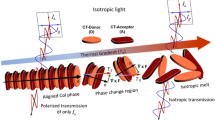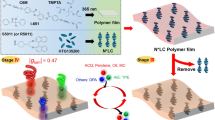Abstract
Optical information processing, display and storage can be accomplished with linearly or circularly polarized light. In passive (non-emitting) devices, linear polarization can be produced by anisotropic absorption of light1, whereas circular polarization has been attained by selective reflection of unpolarized light propagating through a chiral-nematic liquid-crystal film2. Active (light-emitting) devices capable of polarized emission are also needed. In principle, optical and electronic excitation of materials containing uniaxially and helically arranged luminophores should produce linearly and circularly polarized emission, respectively. In practice, the former is easier to achieve and is therefore more technologically advanced3,4,5,6,7,8. Here we report the generation of strongly circularly polarized photoluminescence from films of glass-forming chiral-nematic liquid crystals9 in which are embedded light-emitting dopants. This host material apparently induced alignment of the luminophores to a degree that produces almost pure circular polarization within the 400–420-nm wavelength band of the emitted light. We anticipate that composite films of this sort might find applications within photonic technology such as colour-image projection10 and stereoscopic displays11.
This is a preview of subscription content, access via your institution
Access options
Subscribe to this journal
Receive 51 print issues and online access
$199.00 per year
only $3.90 per issue
Buy this article
- Purchase on Springer Link
- Instant access to full article PDF
Prices may be subject to local taxes which are calculated during checkout



Similar content being viewed by others
References
Dirix, Y., Tervoort, T. A. & Bastiaansen, C. Optical properties of oriented polymer/dye polarizers. Macromolecules 28, 486–491 (1995).
Schadt, M. & Fünfschilling, J. New liquid crystal polarized color projection pinciple. Jpn J. Appl. Phys. 29, 1974–1984 (1990).
Montali, A., Bastiaansen, C., Smith, P. & Weder, C. Polarizing energy transfer in photoluminescent materials for display applications. Nature 392, 261–264 (1998).
Dyreklev, P.et al. Polarized electroluminescence from an oriented substituted polythiophene in a light emitting diode. Adv. Mater. 7, 43–45 (1995).
Era, M., Tsutsui, T. & Saito, S. Polarized electroluminescence from oriented p-sexiphenyl vacuum-deposited film. Appl. Phys. Lett. 67, 2436–2438 (1995).
Cimrová, V., Remmers, M., Neher, D. & Wegner, G. Polarized light emission from LEDs prepared by the Langmuir-Blodgett technique. Adv. Mater. 8, 146–149 (1996).
Sariciftci, N. S., Lemmer, U., Vacar, D., Heeger, A. J. & Janssen, R. AJ. Polarized photoluminescence of oligothiophenes in nematic liquid crystalline matrices. Adv. Mater. 8, 651–654 (1996).
Lüssem, G.et al. Polarized electroluminescence of light emitting liquid crystalline polymers. Liq. Cryst. 21, 903–907 (1996).
Chen, S. H., Shi, H., Conger, B. M., Mastrangelo, J. C. & Tsutsui, T. Novel vitrifiable liquid crystals as optical materials. Adv. Mater. 8, 998–1001 (1996).
Heynderickx, I. E. J. R. & Broer, D. J. Illumination system for a color projection device and circular polarizer suitable for use in such an illumination system, and color image projection device comprising such an illumination system and circular polarizer.US Patent No. 5,626,408 ((1997)).
Hall, D. R. Use of stereoscopic systems utilizing chiral liquid crystals.US Patent No. 5,699,184 ((1997)).
Langeveld-Voss, B. M. W.et al. Circular dichroism and circular polarization of photoluminescence of highly ordered poly{3,4-di[(S)-2-methylbutoxy]-thiophene}. J. Am. Chem. Soc. 118, 4908–4909 (1996).
Shi, H., Conger, B. M., Katsis, D. & Chen, S. H. Circularly polarized fluorescence from chiral nematic liquid crystalline films: theory and experiment. Liq. Cryst. 24, 163–172 (1998).
Peeters, E.et al. Circularly polarized electroluminescence from a polymer light-emitting diode. J. Am. Chem. Soc. 119, 9909–9910 (1997).
Katsis, D., Schmid, A. W. & Chen, S. H. Mechanistic insight into circularly polarized photoluminescence from a chrial-nematic film. Liq. Cryst.(in the press).
Wu, S. T., Efron, U. & Hess, L. D. Birefringence measurements of liquid crystals. Appl. Opt. 23, 3911–3915 (1984).
Il'chishin, I. P., Tikhonov, E. A., Tishchenko, V. G. & Shpak, M. T. Generation of a tunable radiation by impurity cholesteric liquid crystals. JETP Lett. 32, 24–27 (1981).
Acknowledgements
We thank R. W. Boyd, L. J. Rothberg and S. D. Jacobs for discussions. This work was supported by the US National Science Foundation, US Department of Energy, and the Japanese Ministry of International Trade and Industry.
Author information
Authors and Affiliations
Corresponding author
Rights and permissions
About this article
Cite this article
Chen, S., Katsis, D., Schmid, A. et al. Circularly polarized light generated by photoexcitation of luminophores in glassy liquid-crystal films. Nature 397, 506–508 (1999). https://doi.org/10.1038/17343
Received:
Accepted:
Issue Date:
DOI: https://doi.org/10.1038/17343
This article is cited by
-
Recent advances in chiral AIE polymers
Journal of Nanoparticle Research (2023)
-
Liquid crystal-templated chiral nanomaterials: from chiral plasmonics to circularly polarized luminescence
Light: Science & Applications (2022)
-
Controlling anisotropic properties by manipulating the orientation of chiral small molecules
Nature Chemistry (2022)
-
Simultaneous emission of orthogonal handedness in circular polarization from a single luminophore
Light: Science & Applications (2019)
-
Aggregation-amplified circularly polarized luminescence from axial chiral boron difluoride complexes
Science China Chemistry (2019)
Comments
By submitting a comment you agree to abide by our Terms and Community Guidelines. If you find something abusive or that does not comply with our terms or guidelines please flag it as inappropriate.



